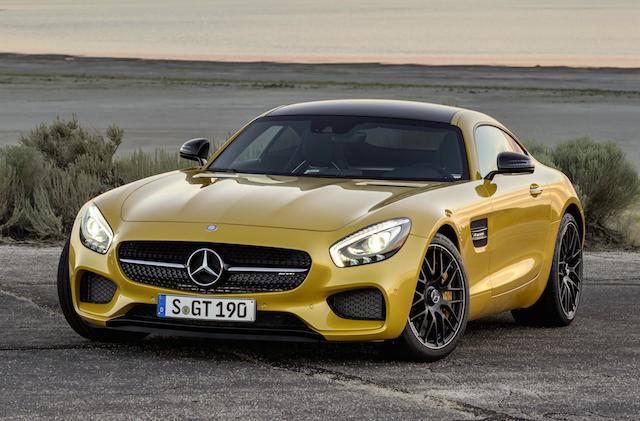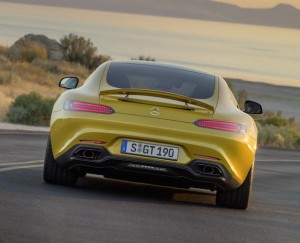
Mercedes-Benz has broken with tradition by dropping the ‘Benz’ name from the go-fast coupe it calls the Mercedes-AMG GT. The new model and its twin-turbocharged V8 engine is a product of Mercedes-Benz and its wholly owned performance house AMG.
 The German carmaker dropped the ‘Benz’ handle because it wanted to give the new model its own identity, just as it did with the SLS AMG super car. But whereas the SLS was a limited edition – 2010-2014 production – the AMG GT enters a longer-term cycle, challenging cars like the Porsche 911, Aston Martin V8 Vantage Coupe, Jaguar F-Type Coupe R, and Maserati GranTurismo.
The German carmaker dropped the ‘Benz’ handle because it wanted to give the new model its own identity, just as it did with the SLS AMG super car. But whereas the SLS was a limited edition – 2010-2014 production – the AMG GT enters a longer-term cycle, challenging cars like the Porsche 911, Aston Martin V8 Vantage Coupe, Jaguar F-Type Coupe R, and Maserati GranTurismo.
Also, the SLS AMG costs upwards of NZ$450,000 and uses a 6.2-litre naturally aspirated V8; the AMG GT is expected to start around NZ$250,000 and uses a handbuilt 4.0-litre twin-turbocharged V8. The AMG GT might have a similar silhouette to the SLS, but it is a completely new design, a feature that has already turned one New Zealander’s head.
 “We sold one this morning (Sept.11),” said Mercedes-Benz NZ general manager Ben Giffin. “It surprised me because we have tried to keep the info quiet. It’s been under wraps for some time and I didn’t think it was going to be unveiled until (next month’s) Paris show.”
“We sold one this morning (Sept.11),” said Mercedes-Benz NZ general manager Ben Giffin. “It surprised me because we have tried to keep the info quiet. It’s been under wraps for some time and I didn’t think it was going to be unveiled until (next month’s) Paris show.”
Giffin expects the first shipment of 15-20 cars to land here next July, made up of the base model GT and the flagship GT S. “We’ll struggle to get more than that because of demand elsewhere,” he said. He expects NZ buyers to favour the more powerful car. “The majority of sales will push towards the GT S. We have found with AMG in the past that most buyers want the performance pack.”
The AMG GT comes in two different states of tune. The twin-turbo V8 in the GT generates 340kW at 6000rpm and 600Nm of torque from 1600-5000rpm; the engine in the flagship GT S has been tweaked to deliver 375kW at 6250rpm and 650Nm from 1750-4750rpm.
The GT S (1570kg) sprints from 0-100km/h in a claimed 3.8 seconds, on its way to an electronically limited top speed of 310km/h.?The GT (1540kg) gets to 100km/h in 4.0 seconds, going on to a governed 304km/h.
 The GT uses aluminium components on more than 90 per cent of the spaceframe. The bodyshell is made from light alloy, the bootlid is steel and the front deck is magnesium. Much of the suspension – double wishbone front and rear – is made from aluminium. Weight distribution is 47:53 front/rear.
The GT uses aluminium components on more than 90 per cent of the spaceframe. The bodyshell is made from light alloy, the bootlid is steel and the front deck is magnesium. Much of the suspension – double wishbone front and rear – is made from aluminium. Weight distribution is 47:53 front/rear.
Power goes to the rear wheels via a seven-speed dual-clutch transaxle gearbox, mounted at the rear axle like that in the SLS. Drivers can alter shift and response times with modes including Controlled Efficiency, Sport, Sport Plus and Individual. The GT S also gets a Race mode for racetrack use.
The GT S has an electronic rear differential, to improve traction and boost cornering speeds, says the carmaker. Optional on the GT but standard on the GT S is the AMG Ride Control set-up which can alter the damping.
 The GT has speed-sensitive sports steering and the GT S is available with the optional AMG Dynamics Plus package, which includes engine and transmission mounts that help boost comfort levels and reduce noise, vibration and harshness.
The GT has speed-sensitive sports steering and the GT S is available with the optional AMG Dynamics Plus package, which includes engine and transmission mounts that help boost comfort levels and reduce noise, vibration and harshness.
The GT gets 360mm brake discs on each wheel, the GT S has 390mm discs. Ceramic brakes are an option on both models. Both cars ride on 19-inch alloys, the GT shod with 255/35 front and 295/35 rear tyres, the GT S with 265/35 up front and 295/30 at the rear.

